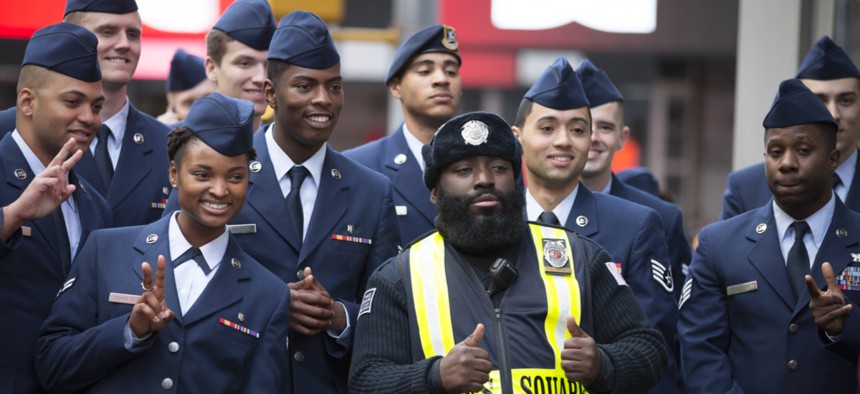The Future Airman is a Hacker

A group of U.S. Air Force personnel take a picture with a Times Square Public Safety Officer after the annual Americas Parade up 5th Avenue on Veterans Day in Manhattan in 2015. Glynnis Jones/Shutterstock.com
Air Force recruiters will prize computer skills more highly, while the service will encourage airmen to experiment with their own solutions
Forget the flight suit. The ideal airman of the future has serious tech chops in programming, signals intelligence, or some other core technological capability and isn’t afraid to break things. The Air Force is looking to begin recruiting more intensively for these core competencies, in anticipation of the ways artificial intelligence will change the nature of air war.
“At what point do we give airmen credit for things that they’ve already done or expertise that they may already have—instead of a recruitment system that is focused on, ‘We have to fill certain skill sets’?” Chief Master Sgt. Mark Allen, the service’s senior enlisted advisor for intelligence, surveillance and reconnaissance, said at an Air Force Association event last Thursday. “If I have an airman coming in that has a computer engineering degree, or has machine language capability, or has some other type of experience, we have to make sure that we are identifying that and that we are purposely placing that airmen in something where we can benefit off of that.”
Allen added that recruiters were also increasingly looking for language proficiency and cryptography skills.
He said that re-examination will go both ways. As the Air Force looks to recruit programmers, they’ll also do more continuous evaluation on current airmen, to make sure that the fit is still good. You might read that to mean that they will work to ensure that some people already in key spots are keeping up with best practices and new technologies. “There are certain career fields that we bring in where there are only one or two tests that kind of give us a baseline assessment,” he said. “Those are all pretty old now. We have to look at how we modernize that.”
That’s all linked to how the Air Force expects artificial intelligence to change core aspects of intelligence and reconnaissance. For instance, airmen traditionally spend a lot of time on processing, exploitation, and dissemination, or PED. Those tasks will increasingly go to machines, said Lt. Gen. VeraLinn “Dash” Jamieson, deputy chief of staff for intelligence, surveillance and reconnaissance.
Jamieson said airmen’s future holds less PED and more SIAS: “sense, identify, attribute, share.”
“What machine intelligence is going to do is remove the airmen from actually identifying objects. What our airmen have to do is critically think, not just code but use a variety of different skill sets,” she said.
A lot of that sensing, attributing, and sharing will happen through innovative use of digital tools and, in many cases, customizing open-source or consumer software. In a separate recent appearance, Jamieson made the point that she’s not exactly looking for industry to hand the service neat new software suites and gadgets for airmen. Rather, she wants to harness good ideas and solutions that are emerging from the ranks. Industry can play a collaborative role or they can get the hell out of the way.
“We’ve met airmen who have coded and developed tools to streamline collection between various platforms,” said Jamieson. “Airmen at the 480th ISR wing realized that the software in their favorite video game… allowed for coordination between approximately 55 users in real time. The software that they were using could be used for training. We have a weapons system, a [distributed common ground weapon system] and we have no trainer for that weapons system … The weapons system is called the Sentinel. These airmen went, ‘Oh my gosh, this video game could be used to train us.’ The team built their own version called Sentinel Sim with a handful of computers and $60 worth of additional expenses. If we had put that out [with a formal call to industry] it probably would have cost millions to institutionalize,” she said. (She declined to name the game that the airmen built Sentinel Sim out of, citing potential copyright issues.)
“This is what I’m talking about when I say we have to have a paradigm shift,” she told the largely industry crowd. “We want them to solve their problems but we want them to partner with all of you in doing so.”



